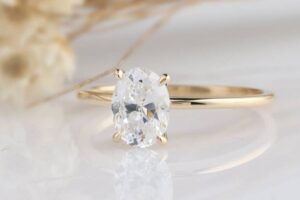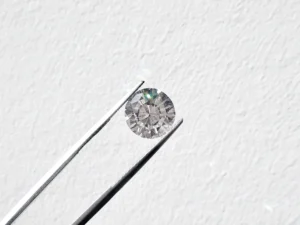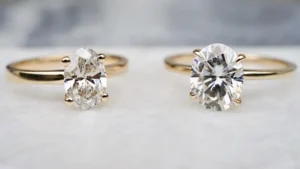Moissanite was discovered in 1893 by the Nobel Prize-winning French chemist Dr Henri Moissan. His research at the time was focused on specific crystalline chemical compounds ideal for efficient electrical conduction. During the search, Dr Moissan discovered minute amounts of a new mineral, silicon carbide – a remarkable and extremely rare mineral – in the fragments of a meteorite crater in Arizona, USA. Initially, he thought he had found diamonds. Until years after his discovery, and with extensive research, Moissan concluded that this mineral had a different chemical composition and was, in fact, natural silicon carbide (SiC). Subsequently, in 1905, this mineral was named “moissanite” in his honor.
What exactly is a Moissanite? Is it a substitute for diamond produced in a laboratory?

No, not in any case. It has been more than 120 years since its discovery in nature and now, moisanite gemstones have come a long way from being just silicon carbide. Today – due to its rarity in nature – moissanite, as we explain below, is created in special laboratories with minimal environmental impact. Because of its durability, Moissanite can be cut in a variety of cuts, which give jewelry designers a plethora of options for engagement rings. Its exceptional brilliance and the variety of shapes which you will find in our jewelry store are the two factors that differentiate this beautiful gemstone from diamonds and other similar stones. Regardless of the shape that suits your style, there is nothing better than seeing this stunning gemstone in person at our boutique.
Moissanite – Moissanite, then, is the name given to this particular natural or laboratory crystal composed of silicon carbide (SiC). Its occurrence in nature is extremely rare and has only been found in upper mantle rocks and meteorites, in the size of tiny grains, naturally unsuitable for use in jewellery. Scientific analyses of meteorites suggest an extraterrestrial origin, outside our Solar System. Silicon carbide is commonly found around specific stars, as indicated by their infrared spectra.
In addition to its beauty and mysterious origin, one of the most remarkable properties of Moissanite is its durability, something only diamond is famous for. Given that Moissanite is ranked as the second hardest gemstone on earth after diamond, you can be sure that you will get a stone that you will enjoy for a lifetime. By choosing moisanite, you can be sure that you are buying lasting brilliance and durability, and that you will enjoy your ring every day as much as the first day you received it.
Since its discovery, Moissanite has been hailed as the ultimate choice if for whatever reason you do not wish to buy a diamond. Because of its shiny appearance and considerable durability, it bears a striking resemblance to diamond. Although comparable, the chemical composition and properties of these stones are very different. Jewelry enthusiasts around the world are adding moissanite to their collection because of its social responsibility, brilliance, incredible beauty, hardness, and affordability.
Moissanite splendour

It has not unfairly taken the title of “the world’s most glittering stone”. The brilliance of moissanite is sure to dwarf all other gemstones. In fact, in terms of brilliance we can say that moisanite shines even brighter than a diamond. For reference, the diamond’s refractive index is estimated at 2.42, while Moisanite is placed at 2.65. This makes the stone dense and incredibly brilliant. Moissanite presents an impressive rainbow effect. Because of its high refractive index (refractive indices refer to a stone’s ability to bend and reflect light), its brilliance is unrivalled. This means that whether you want to sparkle for a special occasion or when exchanging your wedding vows, the brilliance of moissanite will mesmerize you.
Toughness and Hardness of Moissanite

Geologists worldwide use a scale called the Mohs scale to measure the hardness of minerals and their resistance to scratching. The scale ranges from 1 to 10, with 10 being the hardest, a position held only by diamond. Moissanite, this impressive gemstone follows with a score of 9.25. This means that Moissanite is harder than other popular gemstones, such as sapphires and rubies which are at 9 and emeralds which are at 7.5 on the Mohs scale. Its hardness therefore makes moisanite very resistant to the effects of everyday wear and tear, but buying moisanite is not only an affordable luxury, but also a durable option when looking for a great alternative to diamonds.
An engagement ring should be made to last, as it symbolizes a very important part of our lives. This means that what we look for is jewellery that is not prone to scratching, chipping or breaking. We are looking for a “stone for life”. Moissanite is created to withstand daily wear and tear and last for generations. Also, its impeccable clarity, color and luster will not diminish over time. Many jewelry enthusiasts love moissanite because of its unique brilliance and radiant fire. For those who love to add a little sparkle to their lives, the radiant sheen of moisanite does not disappoint.
Transparency and clarity
Another remarkable characteristic of moisanite is its excellent clarity. Clarity is determined by the number (or lack thereof) and distinctness of inclusions found within the stone. The system used to classify diamonds (the 4 C’s which include color, cut, clarity and carat weight) can also be used to classify the quality of moisanite. At Mil-Or we use only the highest quality moisanite, and our moisanites come with international certification.
Color
Moissanite is found in both colourless and fancy varieties. Whether you choose a colourless, near colourless or fancy coloured moisanite, the colour will not change or dull over time, provided of course that normal use is made of the jewellery.
Formation of Moissanite
Since natural Moissanite is extremely rare and very expensive, scientists have found a way to recreate its stunning beauty in the laboratory. In the late 1990s, researchers from North Carolina developed and patented a specific process for creating pure silicon carbide. The process of creating moisanite is difficult and time-consuming, taking two to three months to create a single crystal through a long, painstaking sublimation process. Moissanite is formed under controlled conditions using a combination of pressure and high heat (1 800-2 600 °C) in an inert atmosphere in specially designed laboratories. The moisanite crystals are then cut and polished into various shapes and sizes (carats) and set in precious metals such as gold and platinum. Moissanite can be set in all the bindings which diamonds and other gemstones are usually set.
Eva Kountouraki GG, AJP, JBM
Gemology Instructor, Jewellery Consultant


